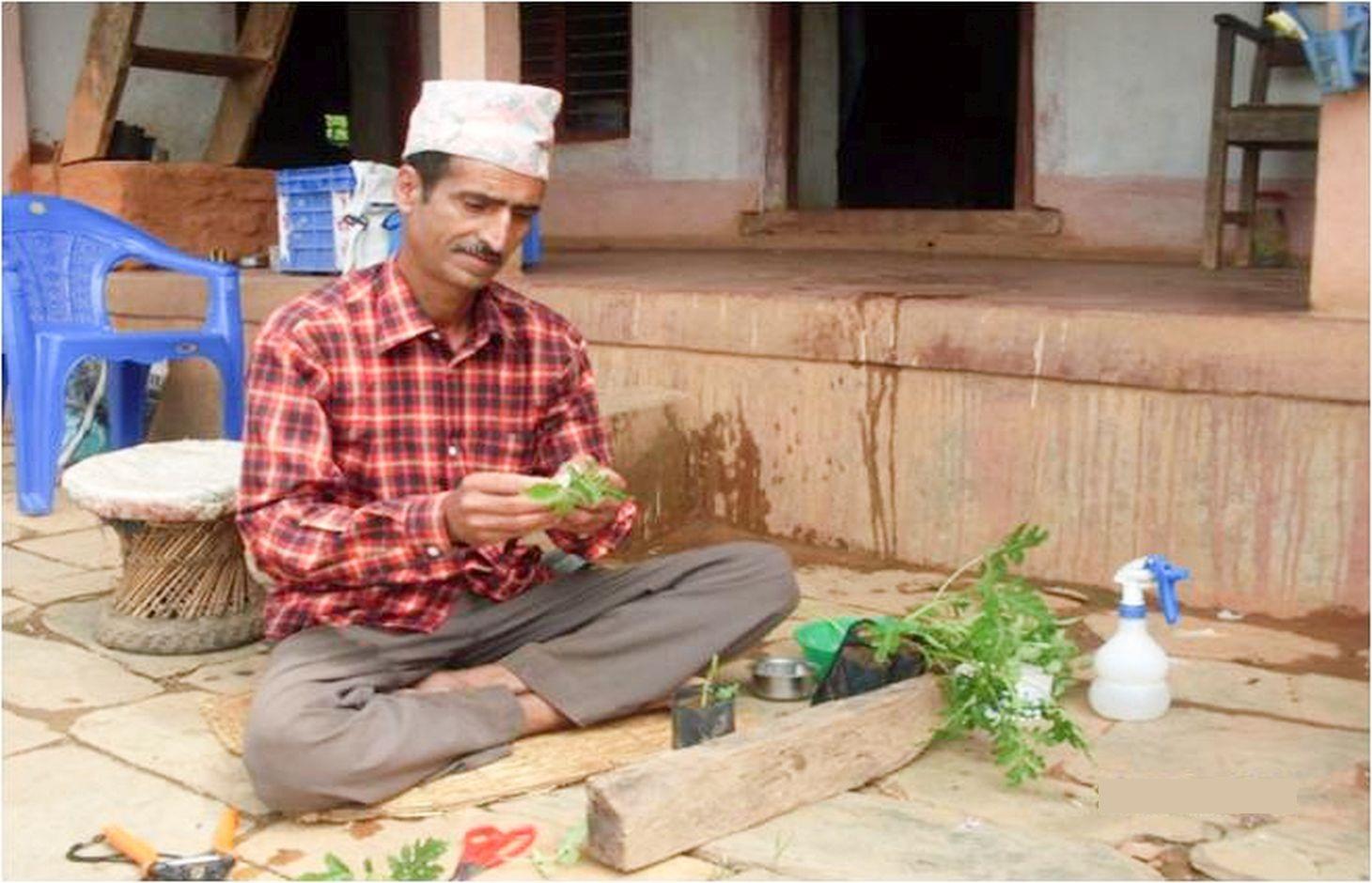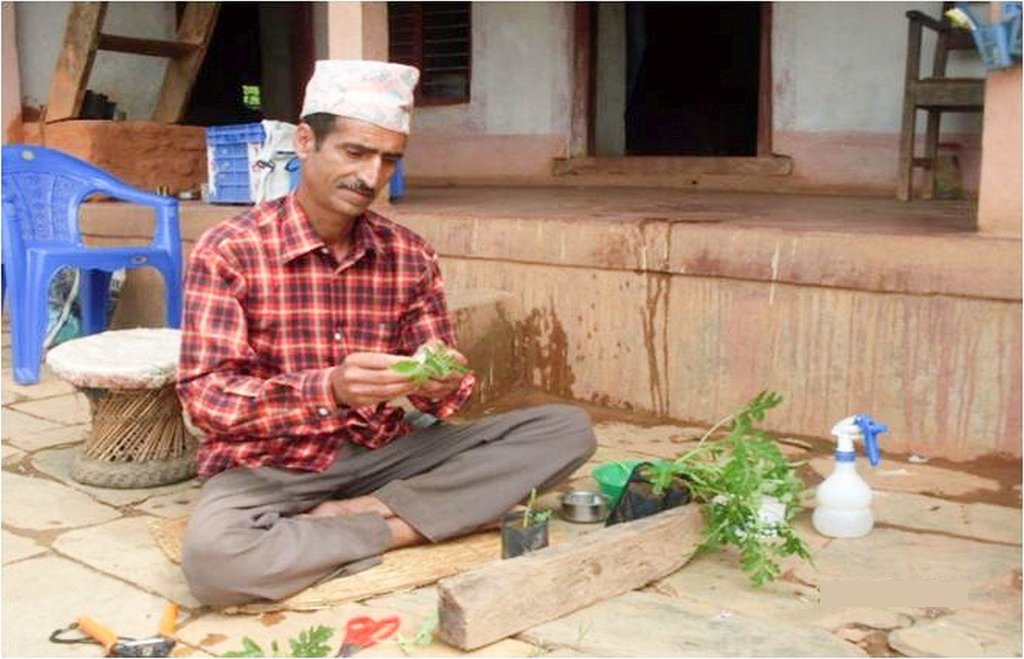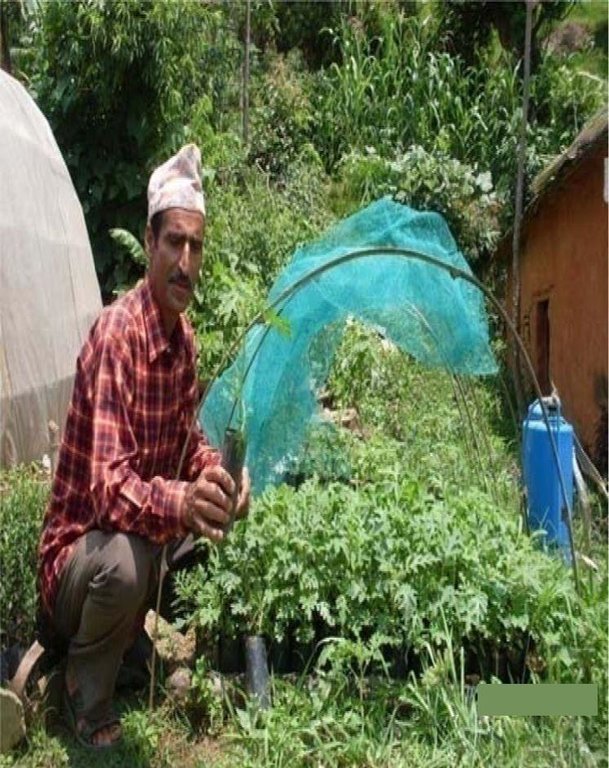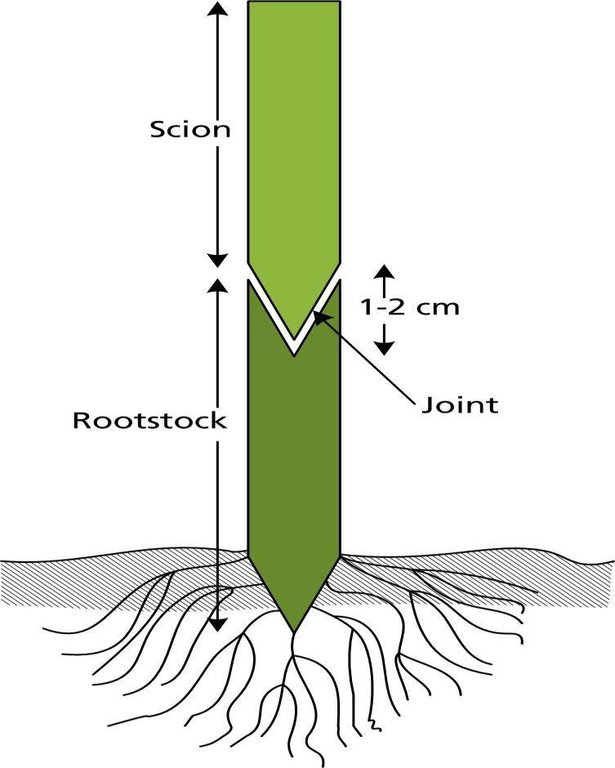Tomato Grafting [Nepal]
- Creation:
- Update:
- Compiler: Shreedip Sigdel
- Editor: –
- Reviewers: David Streiff, Alexandra Gavilano
Kalami Prabidhi Dwara Golbheda Uthapadan (Main Contributor: Purusottam Gupta, IDE Nepal)
technologies_1694 - Nepal
View sections
Expand all Collapse all1. General information
1.2 Contact details of resource persons and institutions involved in the assessment and documentation of the Technology
SLM specialist:
Gupta Purusottam
IDE-Nepal, currently NEAT project
India
SLM specialist:
Name of the institution(s) which facilitated the documentation/ evaluation of the Technology (if relevant)
ICIMOD International Centre for Integrated Mountain Development (ICIMOD) - NepalName of the institution(s) which facilitated the documentation/ evaluation of the Technology (if relevant)
iDE Nepal (iDE Nepal) - Nepal1.3 Conditions regarding the use of data documented through WOCAT
The compiler and key resource person(s) accept the conditions regarding the use of data documented through WOCAT:
Yes
1.5 Reference to Questionnaire(s) on SLM Approaches (documented using WOCAT)
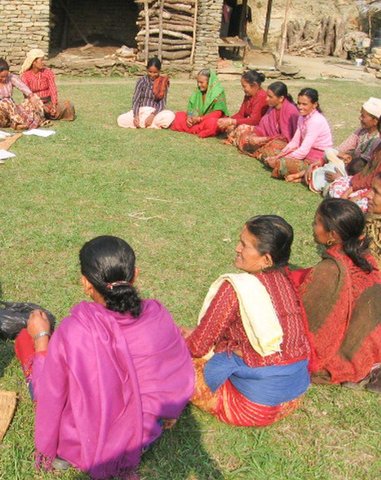
Using the participatory market chain approach to help … [Nepal]
Discussions and structured interactions between farmers and the different actors involved throughout the market chain can help to stimulate joint innovations based on shared ideas and mutual trust.
- Compiler: Shreedip Sigdel
2. Description of the SLM Technology
2.1 Short description of the Technology
Definition of the Technology:
Cleft grafting can be used to produce plants that are resistant to a number of pests and diseases and are often higher yielding than the original. Tomato seedlings can be easily grafted onto resistant root stock of the wild eggplant (Solanum sysimbrifolium) to produce a disease-resistant and commercially viable crop.
2.2 Detailed description of the Technology
Description:
Some of Nepal's most lucrative vegetable cash crops, especially solanaceous crops such as tomato and eggplant, are particularly susceptible to attack by the root knot nematode, Meliodogyne spp, which costs Nepal's farmers millions of rupees in losses annually. In recent years, farmers found that this pest was becoming prevalent and that they could not control it permanently using either cheap or eco-friendly solutions. Researchers and development officers took up the challenge and found that grafting technology could successfully control not only the root knot nematode but also wilting disease. As a bonus, they also found that grafting can increase the yield potential of the plants and improve the overall productivity of the land.
Establishment / maintenance activities and inputs: Loam and silt loam soils with a pH of 6.0–7.0 are the most suitable for this type of cultivation. Grafting technology requires two plants: the scion and the rootstock. The scion is a detached shoot or twig containing buds from the desired woody plant. The rootstock is a plant with an established healthy root system, onto which a cutting or a bud from another plant is grafted. The scion seedlings are grown in raised solarized nursery beds, where care has been taken to see that the soil has been sterilised and all soil pests have been destroyed. Robust rootstock of wild eggplant (Solanum sysimbrifolium) is appropriate for tomato propagation. The rootstock seedlings are grown in multi cell trays and transplanted when they are 20–25 cm high and have a few leaves and a pencil thick stalk. Seeds for the rootstock seedlings are sown in March/April and are ready in 6–8 weeks; scion seeds are sown in April/May and are ready for grafting in 3–4 weeks. Both scion and rootstock plants should have achieved similar stalk thicknesses at the time of grafting. Cleft grafting is carried out and the grafted seedlings kept in polypots in a closed polyhouse for 7–10 days. Then the grafted seedlings are carefully transplanted to their permanent location. The grafted plants are watered the day after they are transplanted; the extent of watering depends on how moist the soil is and on local weather conditions. The field is mulched throughout the cropping period using straw and other farm biomass materials.
2.3 Photos of the Technology
2.5 Country/ region/ locations where the Technology has been applied and which are covered by this assessment
Country:
Nepal
Further specification of location:
Arukharka -6, Syangja District
Specify the spread of the Technology:
- evenly spread over an area
If precise area is not known, indicate approximate area covered:
- < 0.1 km2 (10 ha)
2.7 Introduction of the Technology
Specify how the Technology was introduced:
- through projects/ external interventions
3. Classification of the SLM Technology
3.1 Main purpose(s) of the Technology
- improve production
3.2 Current land use type(s) where the Technology is applied

Cropland
- Annual cropping
- tomatoes
Comments:
Major land use problems (compiler’s opinion): Insufficient water for irrigation, the soil is acidic, vegetable crops are attacked by pests and crop production is in decline.
3.4 Water supply
Water supply for the land on which the Technology is applied:
- rainfed
3.5 SLM group to which the Technology belongs
- integrated pest and disease management (incl. organic agriculture)
- improved plant varieties/ animal breeds
3.6 SLM measures comprising the Technology

agronomic measures
- A5: Seed management, improved varieties
3.7 Main types of land degradation addressed by the Technology

chemical soil deterioration
- Cn: fertility decline and reduced organic matter content (not caused by erosion)

biological degradation
- Bp: increase of pests/ diseases, loss of predators

water degradation
- Hs: change in quantity of surface water
Comments:
Main causes of degradation: soil management, other human induced causes (specify) (Overuse of chemical Fertilizer), droughts
3.8 Prevention, reduction, or restoration of land degradation
Specify the goal of the Technology with regard to land degradation:
- prevent land degradation
4. Technical specifications, implementation activities, inputs, and costs
4.1 Technical drawing of the Technology
Technical specifications (related to technical drawing):
Schematic diagram of a tomato scion grafted on to the rootstock of a wild eggplant.
Technical knowledge required for field staff / advisors: high
Main technical functions: Reduce Pest Attack, Improve crop production
Author:
A. K. Thaku
4.2 General information regarding the calculation of inputs and costs
other/ national currency (specify):
NPR
If relevant, indicate exchange rate from USD to local currency (e.g. 1 USD = 79.9 Brazilian Real): 1 USD =:
72.0
4.3 Establishment activities
| Activity | Timing (season) | |
|---|---|---|
| 1. | Prepare the land | |
| 2. | Prepare Scions | |
| 3. | Prepare rootstock | |
| 4. | Grafting | |
| 5. | Transplant grafted Seedling |
4.4 Costs and inputs needed for establishment
| Specify input | Unit | Quantity | Costs per Unit | Total costs per input | % of costs borne by land users | |
|---|---|---|---|---|---|---|
| Labour | Prepare the land | persons/day | 5.0 | 4.2 | 21.0 | 100.0 |
| Equipment | Tools | unit | 1.0 | 22.0 | 22.0 | 100.0 |
| Plant material | Seeds | unit | 1.0 | 28.0 | 28.0 | 100.0 |
| Fertilizers and biocides | Fertilizer | unit | 1.0 | 17.0 | 17.0 | 100.0 |
| Fertilizers and biocides | Compost/manure | unit | 1.0 | 65.0 | 65.0 | 100.0 |
| Fertilizers and biocides | Pesticide | unit | 1.0 | 21.0 | 21.0 | 100.0 |
| Fertilizers and biocides | Plant tonic | unit | 1.0 | 7.0 | 7.0 | 100.0 |
| Construction material | Polypot,grafting chamber etc | unit | 1.0 | 225.0 | 225.0 | 100.0 |
| Total costs for establishment of the Technology | 406.0 | |||||
| Total costs for establishment of the Technology in USD | 5.64 | |||||
4.5 Maintenance/ recurrent activities
| Activity | Timing/ frequency | |
|---|---|---|
| 1. | Both scion and rootstock seeds are watered after sowing. The seedlings are monitored and watered as needed. (Overall labor: 16 person days) | |
| 2. | After transplanting, the grafted seedlings are watered the next day and twice weekly thereafter. As the plantlets mature, they are watered at 10-day intervals and the surface of the soil is mulched. The moisture level in the soil is monitored throughout the cropping period. | |
| 3. | Top dressing with biofertilizers (N, P, K, and vesicular arbuscular mycorrhiza VAM) and bio-hume is applied to the root zone. |
4.6 Costs and inputs needed for maintenance/ recurrent activities (per year)
| Specify input | Unit | Quantity | Costs per Unit | Total costs per input | % of costs borne by land users | |
|---|---|---|---|---|---|---|
| Labour | Watering scion and rootstock | persons/day | 16.0 | 4.25 | 68.0 | 100.0 |
| Equipment | Electricity and water charger | unit | 1.0 | 8.5 | 8.5 | 100.0 |
| Plant material | Seeds | unit | 1.0 | 68.0 | 68.0 | 100.0 |
| Total costs for maintenance of the Technology | 144.5 | |||||
| Total costs for maintenance of the Technology in USD | 2.01 | |||||
Comments:
Machinery/ tools: spade, scissors, sharp scalpel, multi cell tray, hoe, plough
4.7 Most important factors affecting the costs
Describe the most determinate factors affecting the costs:
All costs and amounts are rough estimates by the technicians and authors.
5. Natural and human environment
5.1 Climate
Annual rainfall
- < 250 mm
- 251-500 mm
- 501-750 mm
- 751-1,000 mm
- 1,001-1,500 mm
- 1,501-2,000 mm
- 2,001-3,000 mm
- 3,001-4,000 mm
- > 4,000 mm
Agro-climatic zone
- sub-humid
Thermal climate class: subtropics
5.2 Topography
Slopes on average:
- flat (0-2%)
- gentle (3-5%)
- moderate (6-10%)
- rolling (11-15%)
- hilly (16-30%)
- steep (31-60%)
- very steep (>60%)
Landforms:
- plateau/plains
- ridges
- mountain slopes
- hill slopes
- footslopes
- valley floors
Altitudinal zone:
- 0-100 m a.s.l.
- 101-500 m a.s.l.
- 501-1,000 m a.s.l.
- 1,001-1,500 m a.s.l.
- 1,501-2,000 m a.s.l.
- 2,001-2,500 m a.s.l.
- 2,501-3,000 m a.s.l.
- 3,001-4,000 m a.s.l.
- > 4,000 m a.s.l.
5.3 Soils
Soil depth on average:
- very shallow (0-20 cm)
- shallow (21-50 cm)
- moderately deep (51-80 cm)
- deep (81-120 cm)
- very deep (> 120 cm)
Soil texture (topsoil):
- medium (loamy, silty)
Topsoil organic matter:
- medium (1-3%)
If available, attach full soil description or specify the available information, e.g. soil type, soil PH/ acidity, Cation Exchange Capacity, nitrogen, salinity etc.
Soil fertility is high
Soil drainage / infiltration is good
Soil water storage capacity is medium
5.4 Water availability and quality
Ground water table:
> 50 m
Availability of surface water:
poor/ none
Water quality (untreated):
good drinking water
5.5 Biodiversity
Species diversity:
- high
5.6 Characteristics of land users applying the Technology
Market orientation of production system:
- mixed (subsistence/ commercial)
Off-farm income:
- 10-50% of all income
Individuals or groups:
- individual/ household
Level of mechanization:
- animal traction
Indicate other relevant characteristics of the land users:
Population density: 200-500 persons/km2
Annual population growth: 0.5% - 1%
Relative level of wealth: rich, average, poor
20% of the land users are rich.
30% of the land users are average wealthy.
50% of the land users are poor.
5.7 Average area of land used by land users applying the Technology
- < 0.5 ha
- 0.5-1 ha
- 1-2 ha
- 2-5 ha
- 5-15 ha
- 15-50 ha
- 50-100 ha
- 100-500 ha
- 500-1,000 ha
- 1,000-10,000 ha
- > 10,000 ha
5.8 Land ownership, land use rights, and water use rights
Land ownership:
- individual, titled
Land use rights:
- individual
Water use rights:
- communal (organized)
6. Impacts and concluding statements
6.1 On-site impacts the Technology has shown
Socio-economic impacts
Production
crop production
Income and costs
farm income
Socio-cultural impacts
food security/ self-sufficiency
Ecological impacts
Biodiversity: vegetation, animals
pest/ disease control
Other ecological impacts
resistance towards pests and disease
maintaining moisture in soil
6.3 Exposure and sensitivity of the Technology to gradual climate change and climate-related extremes/ disasters (as perceived by land users)
Gradual climate change
Gradual climate change
| Season | increase or decrease | How does the Technology cope with it? | |
|---|---|---|---|
| annual temperature | increase | not well |
Climate-related extremes (disasters)
Meteorological disasters
| How does the Technology cope with it? | |
|---|---|
| local rainstorm | well |
Other climate-related consequences
Other climate-related consequences
| How does the Technology cope with it? | |
|---|---|
| reduced growing period | not well |
6.4 Cost-benefit analysis
How do the benefits compare with the establishment costs (from land users’ perspective)?
Short-term returns:
negative
Long-term returns:
positive
How do the benefits compare with the maintenance/ recurrent costs (from land users' perspective)?
Short-term returns:
neutral/ balanced
Long-term returns:
positive
6.5 Adoption of the Technology
Of all those who have adopted the Technology, how many did so spontaneously, i.e. without receiving any material incentives/ payments?
- 91-100%
Comments:
There is a strong trend towards spontaneous adoption of the Technology
Comments on adoption trend: Most (90%) of the farmers are implementing the technology voluntarily and there is a spontaneous trend for adoption. In the area studied, about 20–30 households per year are adopting this technology.
6.7 Strengths/ advantages/ opportunities of the Technology
| Strengths/ advantages/ opportunities in the compiler’s or other key resource person’s view |
|---|
|
The technology is highly effective at controlling pests and disease. How can they be sustained / enhanced? The wild eggplant rootstocks are somewhat difficult to graft because they are spiny. Spine-free rootstock seedlings would be easier to graft. |
|
The grafted seedlings themselves are a good source of income for farmers. How can they be sustained / enhanced? Create awareness among farmers and encourage nurseries to provide grafted seedlings. Support farmers during the start-up stage. |
6.8 Weaknesses/ disadvantages/ risks of the Technology and ways of overcoming them
| Weaknesses/ disadvantages/ risks in the compiler’s or other key resource person’s view | How can they be overcome? |
|---|---|
| Grafting is time consuming and difficult because wild eggplant rootstock plants are spiny. | Need more research to identify other possible rootstock plants. |
| Grafting can be expensive and requires an initial investment in training; specialized materials are needed. Technically demanding, needs practise. Specialized materials are difficult to get. | Nurseries need to be supported and need to have access to specialized materials on time. |
7. References and links
7.1 Methods/ sources of information
Links and modules
Expand all Collapse allLinks

Using the participatory market chain approach to help … [Nepal]
Discussions and structured interactions between farmers and the different actors involved throughout the market chain can help to stimulate joint innovations based on shared ideas and mutual trust.
- Compiler: Shreedip Sigdel
Modules
No modules


